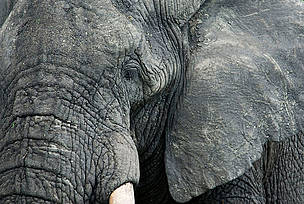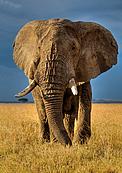The WWF is run at a local level by the following offices...
Once common throughout Africa and Asia, elephant numbers fell dramatically in the 19th and 20th centuries, largely due to the ivory trade and habitat loss. While some populations are now stable, poaching, human-wildlife conflict and habitat destruction continue to threaten the species.
Female elephants are social animals, living in herds with their relatives. Males usually live alone but sometimes form small groups with other males. All elephants need a lot of space, sometimes roaming over incredible areas to find enough food and water to sustain them.
But their habitats are shrinking. African elephant habitat has declined by over 50% since 1979, while Asian elephants are now restricted to just 15% of their original range.
Add in growing human-wildlife conflict and an upsurge in ivory poaching in recent years and it's easy to see why elephants are under threat.
Elephant populations
While some populations of African elephant are secure and expanding, primarily in southern Africa, numbers are continuing to fall in other areas, particularly in central Africa and parts of East Africa. With an estimated 415,000 elephants left on the continent, the species is regarded as vulnerable, although certain populations are being poached towards extinction.Asian elephant numbers have dropped by at least 50% over the last three generations, and they’re still in decline today. With only 40,000-50,000 left in the wild, the species is classified as endangered.
And it is critical to conserve both African and Asian elephants since they play such a vital role in their ecosystems as well as contributing towards tourism and community incomes in many areas.
So by helping protect elephants, we’re helping conserve their habitat, supporting local communities, and making sure natural resources are available for generations to come.

© naturepl.com /Edwin Giesbers / WWF
18 Aug 2020
Partnership seeks to build global alliances and facilitate compliance efforts to uncover the financial networks of criminal syndicates
12 Aug 2020
Telling the difference between an elephant, hippo, and warthog may seem like an easy task, even for the youngest wildlife observers. But if you take ...

© WWF / Christy Williams
What is WWF doing?
The threats facing elephants in Asia and Africa are varied and complex from poaching to habitat loss to human-wildlife conflict.WWF works to conserve elephants on both continents through specific programmes that aim to improve elephant protection and management, build capacity within range states, mitigate human-elephant conflict, and reduce poaching and the illegal ivory trade.

- Don't buy ivory products. The illegal trade in ivory is one of the greatest threats to elephants today.
- Buy and use sustainable palm oil. By purchasing certified sustainable palm oil, retailers, traders and manufacturers can help limit the conversion of Asian elephant habitat into oil palm plantations. Consumers can help by demanding that products contain only sustainable palm oil.
- Buy a gift of chilies, dung and engine oil! Help reduce human-elephant conflict in Africa through this unique purchase.
- Donate to WWF to help support our elephant conservation work.
Did you know?
- The elephant has the longest gestation period of any mammal at 22 months.
- Healthy adult elephants have no natural predators.

© Elephants are among the flagship spices in Uganda © Naturepl.com/AndyRouse/WWFCanon
Infographic

 The WWF Wildlife Crime Scorecard report selects 23 range, transit and consumer countries from Asia and Africa facing the highest levels of illegal trade in elephant ivory, rhino horn and tiger parts.
The WWF Wildlife Crime Scorecard report selects 23 range, transit and consumer countries from Asia and Africa facing the highest levels of illegal trade in elephant ivory, rhino horn and tiger parts.

© Asian Elephant (Elephas maximus). © WWF

TRAFFIC is a joint programme of WWF and the World Conservation Union (IUCN) that monitors the global wildlife trade. TRAFFIC also works in close co-operation with CITES.



